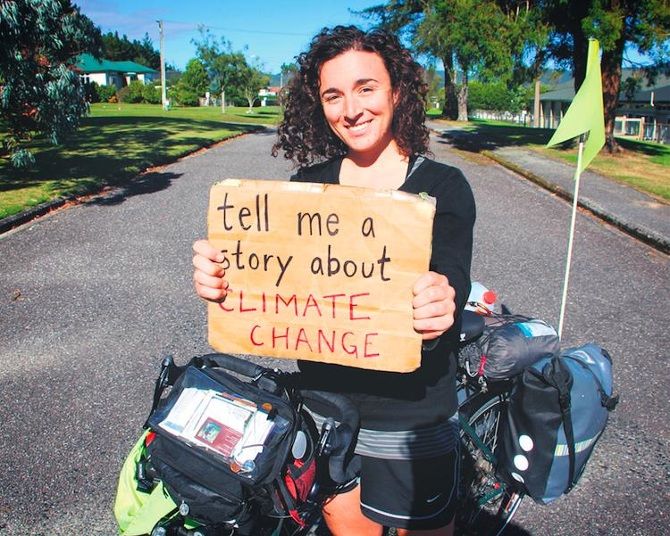Globetrotting Cyclist Is Collecting 1,001 Climate Change Stories
Published on by Water Network Research, Official research team of The Water Network in Non Profit
Devi Lockwood activist-touring cyclist traveling the world (mostly by bicycle) to collect 1,001 stories from people she meets about climate change and its effects on water supply.
By Devi Lockwood

I’m 24 years old, and I believe that water and climate change are the defining issues of my generation. The way I see it, listening is a form of activism.
My journeys as a poet-activist-touring cyclist began three years ago at the People’s Climate March in New York. I wore a cardboard sign around my neck that said “tell me a story about water” on one side and “tell me a story about climate change” on the other, joining a rising tide of 400,000 activists.
That day people told stories about all sorts of things: of the health impacts of paper mill pollution on a community in northern China; climate change’s threats to Vermont’s maple syrup industry; and the experience of being stuck in an office building for 62 hours during Hurricane Sandy.
Since the 2014 People’s Climate March I have been traveling through 11 countries, mostly by bicycle (and sometimes by boat). To date I have recorded interviews with more than 600 storytellers in the US, Fiji, Tuvalu, New Zealand, Australia, Thailand, Laos, Cambodia, Qatar, Morocco and the UK.
You can follow my progress on my 1,001 stories website.
Here is a sample of some of the stories I have recorded on my journeys so far.
Tuvalu
The highest point on this low-lying coral atoll nation in the Pacific is only four meters (12.5ft) above sea level. With a population just shy of 11,000, Tuvalu is one of the smallest and most remote countries on the planet.I lived in Tuvalu for a month, from December 2014 to January 2015, and during that time I made friends with Losite, a Tuvaluan my age, who invited me to the outer island of Nukufetau to spend Christmas with her family.
Losite (far right) with members of her family in Funafuti, Tuvalu. Photograph: Courtesy of Devi Lockwood
Losite’s mother, Nisikata, works as a primary school teacher in Nukufetau. We sat overlooking the sea. She told me the story of a drought that lasted from April to December 2013: “Our local taro crops [and] the fish died because of the drought,” she said. “We usually get water from rain. And when we [went to] fetch water from our tank … it’s all empty.
“The underground well water [was] also salty,” Nisikata said. “There used to be a freshwater lens under Tuvalu. In the last 15 years, due to sea level change, that freshwater lens has become salty and impossible to drink.”
“With the drought, so many things that affected our life, like our livestocks. We depend on pigs, [and were] also facing problem by finding food. Coconuts are not bearing fruit … green nuts are all falling down. [It was] very hard to find anything to drink,” she said.
“Donors from overseas gave bottles of water and those waters [were] distributed to each island and also into schools by the government of Tuvalu. And from there we can survive.”
Rations of food were also provided to each island. “Bit by bit we used those and when we run out of the ration, the government still providing us with more until we were back again to our normal weather: sunny, warm and then sometimes rain.”
Australia
Partway through my six months of cycling up Australia’s east coast, I pedalled through Wooyung, in New South Wales. Enticed by hand-painted signs for peaches, nectarines, lychees and mangoes, I pulled into Wooyung Rd Fruit and Vegetable Stall. I propped my bicycle next to an array of coconuts.
I bought a banana and a nectarine and listened as Terry, a lifelong farmer in Wooyung, told me the story of how floods are more unpredictable than ever before. He said: “Here we used to get floods in January, February. March was your wet monsoon. Now they can come any time from winter. The biggest flood we had, 2005, was the end of June – 34 inches in about three days.”
This unpredictability impacts which crops Terry is able to plant. “There’s risk planting any crops on the flats now,” Terry said. “You used to be able to plant watermelons, rockmelons, and things on the flats and you seldom got flooded out before maybe January, February. Now, anytime, there’s such a risk,” he said. “Too much money involved to put many crops down on the flats,” Terry said.
Source: The Guardian
Follow Devi here
Media
Taxonomy
- Drinking Water Security
- Water Scarcity
- Water Access
- Water Supply
- Water Scarcity In Desert area
- Climate Change
- Water Supply
- Drinking Water
- Climate Protection
- Environmental Impact
- Climate
- Bicycles
